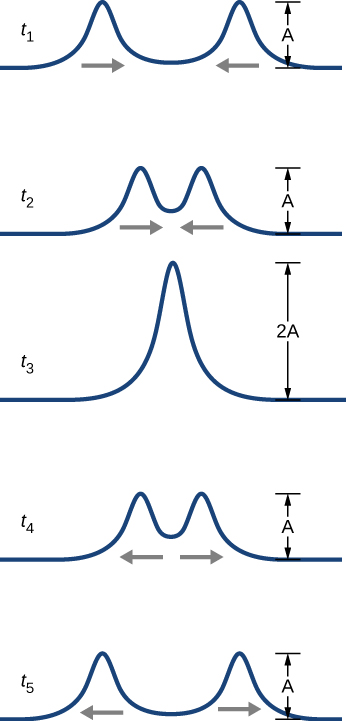| << Chapter < Page | Chapter >> Page > |
Consider two simple pulses of the same amplitude moving toward one another in the same medium, as shown in [link] . Eventually, the waves overlap, producing a wave that has twice the amplitude, and then continue on unaffected by the encounter. The pulses are said to interfere, and this phenomenon is known as interference .

To analyze the interference of two or more waves, we use the principle of superposition. For mechanical waves, the principle of superposition states that if two or more traveling waves combine at the same point, the resulting position of the mass element of the medium, at that point, is the algebraic sum of the position due to the individual waves. This property is exhibited by many waves observed, such as waves on a string, sound waves, and surface water waves. Electromagnetic waves also obey the superposition principle, but the electric and magnetic fields of the combined wave are added instead of the displacement of the medium. Waves that obey the superposition principle are linear waves; waves that do not obey the superposition principle are said to be nonlinear waves. In this chapter, we deal with linear waves, in particular, sinusoidal waves.
The superposition principle can be understood by considering the linear wave equation. In Mathematics of a Wave , we defined a linear wave as a wave whose mathematical representation obeys the linear wave equation. For a transverse wave on a string with an elastic restoring force, the linear wave equation is
Any wave function where the argument of the function is linear is a solution to the linear wave equation and is a linear wave function. If wave functions and are solutions to the linear wave equation, the sum of the two functions is also a solution to the linear wave equation. Mechanical waves that obey superposition are normally restricted to waves with amplitudes that are small with respect to their wavelengths. If the amplitude is too large, the medium is distorted past the region where the restoring force of the medium is linear.
Waves can interfere constructively or destructively. [link] shows two identical sinusoidal waves that arrive at the same point exactly in phase. [link] (a) and (b) show the two individual waves, [link] (c) shows the resultant wave that results from the algebraic sum of the two linear waves. The crests of the two waves are precisely aligned, as are the troughs. This superposition produces constructive interference . Because the disturbances add, constructive interference produces a wave that has twice the amplitude of the individual waves, but has the same wavelength.
[link] shows two identical waves that arrive exactly out of phase, producing destructive interference . [link] (a) and (b) show the individual waves, and [link] (c) shows the superposition of the two waves. Because the troughs of one wave add the crest of the other wave, the resulting amplitude is zero for destructive interference—the waves completely cancel.

Notification Switch
Would you like to follow the 'University physics volume 1' conversation and receive update notifications?